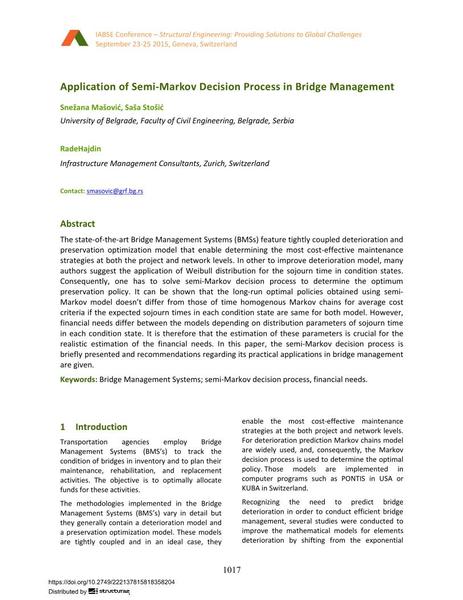Application of Semi-Markov Decision Process in Bridge Management

|
|
|||||||||||
Bibliografische Angaben
| Autor(en): |
Rade Hajdin
Snežana Mašović (University of Belgrade, Faculty of Civil Engineering, Belgrade, Serbia) Saša Stošić (University of Belgrade, Faculty of Civil Engineering, Belgrade, Serbia) |
||||
|---|---|---|---|---|---|
| Medium: | Tagungsbeitrag | ||||
| Sprache(n): | Englisch | ||||
| Tagung: | IABSE Conference: Structural Engineering: Providing Solutions to Global Challenges, Geneva, Switzerland, September 2015 | ||||
| Veröffentlicht in: | IABSE Conference Geneva 2015 | ||||
|
|||||
| Seite(n): | 1017-1024 | ||||
| Anzahl der Seiten (im PDF): | 8 | ||||
| Jahr: | 2015 | ||||
| DOI: | 10.2749/222137815818358204 | ||||
| Abstrakt: |
The state-of-the-art Bridge Management Systems (BMSs) feature tightly coupled deterioration and preservation optimization model that enable determining the most cost-effective maintenance strategies at both the project and network levels. In other to improve deterioration model, many authors suggest the application of Weibull distribution for the sojourn time in condition states. Consequently, one has to solve semi-Markov decision process to determine the optimum preservation policy. It can be shown that the long-run optimal policies obtained using semi- Markov model doesn’t differ from those of time homogenous Markov chains for average cost criteria if the expected sojourn times in each condition state are same for both model. However, financial needs differ between the models depending on distribution parameters of sojourn time in each condition state. It is therefore that the estimation of these parameters is crucial for the realistic estimation of the financial needs. In this paper, the semi-Markov decision process is briefly presented and recommendations regarding its practical applications in bridge management are given. |
||||
